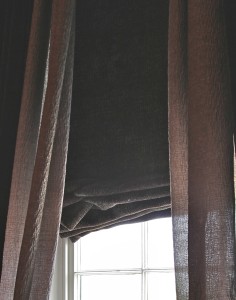The raised surface of fabric created during either of two weaving processes:
a) the weft thread makes a loop at each warp junction, creating fabric such as towelling, pincord, corduroy and repp.
b) the weft threads travel backwards and forwards between two series of warps creating a two layered fabric, a double-faced cloth: when cut apart, it produces two pieces of the same surface pile length, such as velvet.
The pile may stand up or may lie in one direction–it is then known as the nap. It can be tight or loose, thick or fine depending on the denier, a unit of measurement for threads/yarns, and density of the warp and weft threads.
In fact, most fabrics with a pile have some kind of nap, whether it’s immediately visible or not. Sometimes it can look as smooth as a millpond on the table, then when it’s joined and hanging ( and too late) the colour change becomes obvious. For the avoidance of all error of this sort, it’s good practice to get into the habit of marking every piece that you cut. Mark the right side and the top, and use crossed pins or coloured tacks to do so. Pins are the quickest option, but only use them for a fabric that will hold them in easily. It’s annoying when they fall out and the fabric really does look, at this stage, the same from all angles.
Pile affects the colour. When the pile runs down it usually shows the richest tone, and you may have prefer the softer tone that happens with the pile running the opposite way. Consider it, then make the best decision for you- bearing in mind that when pile runs upwards it will collect dust.
For upholstery and cushions the pile must always run downwards and from back to front. Pile fabrics ‘walk’ along each other, so it’s always a mistake to sit a cushion with pile onto a seat base upholstered in the same material – the cushion will never stay in the right place. The platform, or seat deck, must always be upholstered in a strong, non-pile fabric such as cotton twill or loom state linen.

